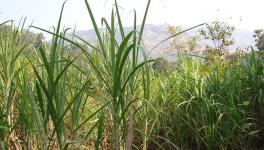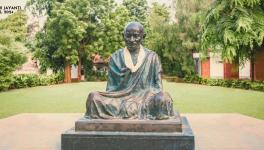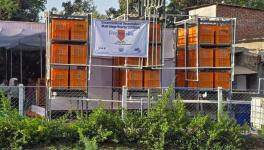Sugarcane Workers of Gujarat District Trapped in Spiral of Debt
Kangadiya Mal, a tribal village in Subir taluka, Dang from where majority of tribals migrate each year to sugarcane fields
Gamjabhai Sebdhubhai Pawar studied till class five when abject poverty forced him to quit school and accompany his parents to harvest sugarcane. Every year, for six or seven months, Pawar would migrate with his parents, who were a koyta unit, or a pair of sugarcane workers, to South Gujarat.
Pawar, 42, a tribal of Kangadiya Mal village, in Subir taluka, Dang, is a small mukkadam, or a labour contractor, and a labourer himself. Two of his four children accompany him to harvest sugarcane. But Rs 10,000-Rs 15,000 earned in the six-seven months is not enough to feed his family of eight, forcing him to borrow Rs 30,000 till early August.
“By the time we leave in September-October, I would be forced to take another loan of, at least, Rs 20,000. The Rs 50,000 loan amount will get deducted from my earnings next season and I will again return with around Rs 10,000,” a disappointed Pawar tells Newsclick, adding how he’s “stuck in the debt spiral”.
Pawar once considered working in the mango or sapota orchards of South Gujarat. “But due to the lack of job stability and to repay the loan, I came back to harvest sugar cane,” says Pawar, one of the few sugarcane workers who have managed to climb up the hierarchy to become labour contractors. He usually recruits 15 koytas, or 30 workers, per harvesting season.
Gamjabhai Pawar, a tribal from Dang who after 20 years of working as a labourer managed to become a small mukkadam
Mukkadams, who are mostly local tribals, are crucial intermediaries between the workers and the sugar mills. They recruit harvesters from their own or neighbouring villages and also loan out money to them on interest which is deducted from their wages at the end of every season.
“A koyta is paid Rs 275 after cutting, cleaning, tying the produce in bundles and loading a tonne of sugarcane, which on an average takes 14-15 hours daily,” says Shantiram Meena of Majdoor Adhikar Manch, a Gujarat-based trade union. “The wages were raised from Rs 250 after the workers struck work in February 2019. The abysmally low wages often force a worker to pair up with his wife, resulting in seasonal migration of entire families with children accompanying their mothers,” says Meena
In 2015, the Gujarat government decided to raise the minimum wage of sugarcane workers to Rs 238 per tonne. Later, the state government increased the minimum wage of an agrarian labourer from Rs 150 to Rs 178 and again raised it to Rs 342.20 in April. The minimum wage of a sugar cane harvester still remains the same.
“The workers slog for as many hours as they can to earn more. Usually, they start their day at 5 am, harvest sugarcane all day and load it into trucks at night. Despite slogging for the whole day, they are many times paid based on the quality of the sugarcane or the precision of harvesting cutting,” says Meena.
Every year, about 2.5 lakh sugarcane workers, who are primarily tribals from South Gujarat and parts of Maharashtra, migrate with their families to the districts of Valsad, Navsari, Surat, Bharuch and Vadodara. “Here, they are employed by 13 sugar mills that run on a cooperative structure. Initially, there were 16 sugar mills but three closed down,” Denish Macwan, secretary, South Gujarat, Majdoor Adhikar Manch tells Newsclick.
“Are they mills workers or agrarian labourers? This lack of identity is exploited by the sugar lobby. A mill annually assigns a supervisor who hires the mukkadams, who recruit these labourers. Though the labourers are paid by the mills, their owners—members of politically influential Patel community—don’t recognise them as their workers. The owners of sugarcane fields refuse to take their responsibility as they don’t pay them,” Macwan says.
If the workers are recognised by the mills, they will have labour rights under the Factories Act, 1948. If they are considered agrarian labourers, their minimum wages, like others, should be determined by the number of hours they work. “But the state government determines their minimum wages by the quantity of sugarcane they harvest. Therefore, they are exploited both by the state government and the Patidar (Patel) community, which runs the sugarcane industry,” adds Macwan.
Jayram Gamit, who was a sugar mill worker for 22 years and is now associated with Majdoor Adhikar Manch, says, “The long excruciating work hours take a toll on the health.”
A 2017 research conducted by the Centre for Labour Research and Action, which works with labourers in the informal sector, revealed that the working and living conditions make sugarcane workers prone to dysentery, vomiting, cough and cold, fever, especially malaria, eye and lung infection and body ache.
At the beginning of every harvesting season, a unit of 15-20 koytas, along with women, children and their belongings, are cramped inside each truck provided by the mill owners. They travel about 200-300 km to the outskirts of villages where they camp for six months.
The mill owners provide them with sticks and plastic sheets to construct makeshift tents that are too small to accommodate a family. The workers stay on usually barren land with no provisions for drinking water, electricity, toilets or even basic medical aid. If a worker gets sick or injured, he/she pays for the treatment or borrows from the mukkadam.
“The employers deduct money for providing plastic sheets, sickles and food grain. If the sickle is damaged or breaks during harvesting, its price is deducted from our wages at the end of the season,” says 34-year-old Kajubhai Somabhai Pawar, a resident of Kangadiya Mal, a tribal village in Dang district. He too had to quit school after class four to accompany his parents to sugarcane fields.
Kajubhai had to quit his study at class four to accompany his parents to sugarcane fields
Pawar migrates every harvesting season along with his wife and two children, aged seven and eight. His two other children, aged 11 and 14, study in a local boarding school.
“Sugarcane harvesting requires a lot of physical strength. The body pains after working 14-15 hours each day. At times, the land where we stay is a few kilometres away from the field. By the end of the season, man workers fall sick,” says Pawar, adding how 1,000-1,200 koyta units defecating daily in the open makes the place impossible to live.
After working and living in inhuman conditions for six months, Pawar returns home with a mere Rs 10,000 or even less. “The money is spent within a month or two and I end up taking loan and pay back 1.5 times the money borrowed,” says Pawar.
The children are the worst sufferers with most of them unable to complete their education. “Girls and boys of our village drop out of school quite early and accompany their parents to the sugarcane fields for additional income. At least, I have ajob guarantee for six months a year. Anyway, I don’t have an option,’ rues Pawar.
Get the latest reports & analysis with people's perspective on Protests, movements & deep analytical videos, discussions of the current affairs in your Telegram app. Subscribe to NewsClick's Telegram channel & get Real-Time updates on stories, as they get published on our website.
























